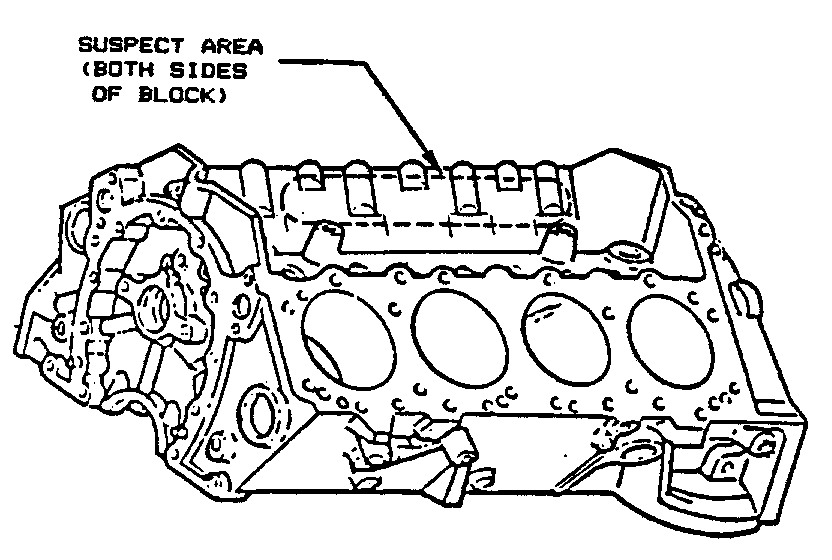LOSS OF ENGINE COOLANT DIAGNOSIS AND REPAIR DESCRIBED

MODELS: 1987-88 TRUCKS EQUIPPED WITH 5.OL AND 5.7L (VIN CODE H AND K) ENGINES
Some 1987 and early 1988 trucks equipped with 5.OL and 5.7L engines may experience loss of coolant which cannot be diagnosed as external coolant leaks.
SERVICE PROCEDURE
A careful inspection should be made for signs of extemal coolant leakage. All hose connections, the water pump weep hole, tbe mating areas between tbe cylinderhead and the block, and any other areas where an external leak can occur should be included in this inspection. When inspecting the cylinder head to block mating area, particular attention should be given to the outboard rear corner on the left cylinder bead.
In addition to the absence of signs of external leakage, internal coolant leakage can usually be confirmed by inspection of the oil on the dipstick for signs of coolant contamination (Turning the oil milky, opaque and lighter brown) or inspection of the underside of the oil filler cap for a creamy light brown residue.
If an internal leak is suspected, a system pressure cbeck sbould be performed.
If leakdown in pressure is experienced and no signs of external leakage have been found, the intake manifold side gaskets are the most likely cause and should be replaced and the underside of the intake manifold inspected for porosity. As an added precaution, during intake manifold gasket replace- ment, the lifter galley walls should be inspected for cracks. (See Inspection Procedure).
INSPECTION PROCEDURE
Inspection can be accomplished in two manners. The first method involves removal of the intake manifold and direct visual inspection of the walls of the galley Particular attention should be given to the areas of the galley within tbe first few inches below the deck (as Illustrated). A casting parting line may also be evident in this area and should not be mistaken for a crack. If an area looks suspect, cracks can be more positively identified by use of a commercially available penetrant dye such as magnaflux "spotcheck". (See Figure No. 1.)
An alternate inspection procedure, effective in many cases, involves removal of the valve covers and inspection of the galley walls by shining a flash- light through the holes in the cylinder head into the galley area and looking for a small buildup of greenish-brown deposits along the face of the wall. A typical crack (and therefore line of deposits) might be two or more inches in length and run approximately parallel to the deek. If no deposit line is evident, but indications of the presence of coolant in the galley area or a light brown creamy residue in the galley area or a light brown creamy residue on the underside of the valve cover is seen during this inspection, the intake manifold gaskets should be replaced and the walls of the galley should be thoroughly inspected for cracks with the intake manifold removed. In addition, the underside of the intake manifold should be inspected for signs of porosity.
In the galley wall if there is evidence of coolant contamination of the oil (as previously described), the lifter feet and camshaft lobes should be in- spected for signs of distress and replaced as necessary. Distress can be identified on the cam by one or more worn lobes with an even wear pattem across the face of the lobe. Distress can be identified on the lifter feet by a less smooth (scratchy, non-reflective) surface finish.
If the block is found to be cracked in the lifter gallery area, it will have to be replaced.
Use P/N'S:
5.OL(H) -10104488 - Partial Engine 5.7L(K) -10104466 - Partial Engine
After an internal coolant leak is repaired, the oil and oil filter should be replaced.
Use the following labor operations and times:
Pressure test cooling system J3010 All Models .3Hr.
Necessary to replace intake manifold gaskets only J0200 C/K 2.0 Hrs. RN 2.2 Hrs. G 2.7 Hrs.
Necessary to replace head gaskets only J0500 Rt. side C/K 4.6 Hrs. R/V 4.9 Hrs. G 5.6 Hrs.
J0501 Lft. side C/K 4.7 Hrs. R 4.7 Hrs. V 4.9 Hrs. G 4.8 Hrs.
J0507 Both sides C/K 7.lHrs. R 7.2Hrs. V 7.4Hrs. G 7.2Hrs.
Necessary to replace partial engine J1820 C 8.7 Hrs K 9.0 Hrs. R 9.0 Hrs V 9.1 Hrs G 12.3 Hrs.
Add Times C/K A/C .2Hr. Air .2Hr.
R/V A/C .4Hr. P/S .2Hr.(R only)
Air .3Hr. Cruise cont. .lHr. G A/C 1.7Hrs. P/S .3Hr. Air .4Hr. Cruise cont. .3Hr.

General Motors bulletins are intended for use by professional technicians, not a "do-it-yourselfer". They are written to inform those technicians of conditions that may occur on some vehicles, or to provide information that could assist in the proper service of a vehicle. Properly trained technicians have the equipment, tools, safety instructions and know-how to do a job properly and safely. If a condition is described, do not assume that the bulletin applies to your vehicle, or that your vehicle will have that condition. See a General Motors dealer servicing your brand of General Motors vehicle for information on whether your vehicle may benefit from the information.
